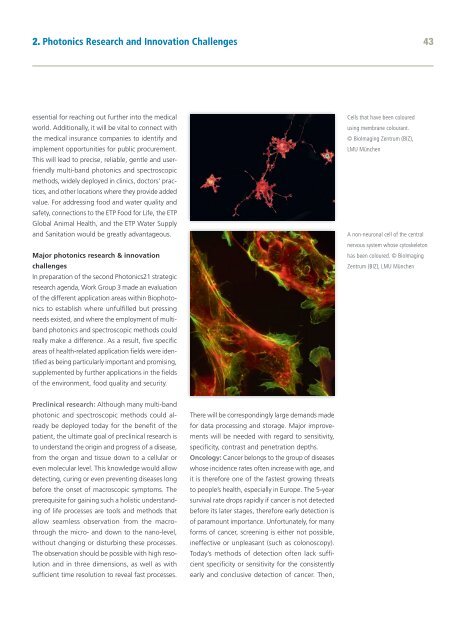Towards 2020 – Photonics driving economic growth in Europe
Create successful ePaper yourself
Turn your PDF publications into a flip-book with our unique Google optimized e-Paper software.
2. <strong>Photonics</strong> Research and Innovation Challenges<br />
43<br />
essential for reach<strong>in</strong>g out further <strong>in</strong>to the medical<br />
world. Additionally, it will be vital to connect with<br />
the medical <strong>in</strong>surance companies to identify and<br />
implement opportunities for public procurement.<br />
This will lead to precise, reliable, gentle and userfriendly<br />
multi-band photonics and spectroscopic<br />
methods, widely deployed <strong>in</strong> cl<strong>in</strong>ics, doctors’ practices,<br />
and other locations where they provide added<br />
value. For address<strong>in</strong>g food and water quality and<br />
safety, connections to the ETP Food for Life, the ETP<br />
Global Animal Health, and the ETP Water Supply<br />
and Sanitation would be greatly advantageous.<br />
Major photonics research & <strong>in</strong>novation<br />
challenges<br />
In preparation of the second <strong>Photonics</strong>21 strategic<br />
research agenda, Work Group 3 made an evaluation<br />
of the different application areas with<strong>in</strong> Bio photonics<br />
to establish where unfulfilled but press<strong>in</strong>g<br />
needs existed, and where the employment of multiband<br />
photonics and spectroscopic methods could<br />
really make a difference. As a result, five specific<br />
areas of health-related application fields were identified<br />
as be<strong>in</strong>g particularly important and promis<strong>in</strong>g,<br />
supplemented by further applications <strong>in</strong> the fields<br />
of the environment, food quality and security.<br />
Cells that have been coloured<br />
us<strong>in</strong>g membrane colourant.<br />
© BioImag<strong>in</strong>g Zentrum (BIZ),<br />
LMU München<br />
A non-neuronal cell of the central<br />
nervous system whose cytoskeleton<br />
has been coloured. © BioImag<strong>in</strong>g<br />
Zentrum (BIZ), LMU München<br />
Precl<strong>in</strong>ical research: Although many multi-band<br />
photonic and spectroscopic methods could already<br />
be deployed today for the benefit of the<br />
patient, the ultimate goal of precl<strong>in</strong>ical research is<br />
to under stand the orig<strong>in</strong> and progress of a disease,<br />
from the organ and tissue down to a cellular or<br />
even molecular level. This knowledge would allow<br />
detect<strong>in</strong>g, cur<strong>in</strong>g or even prevent<strong>in</strong>g diseases long<br />
before the onset of macroscopic symptoms. The<br />
prerequisite for ga<strong>in</strong><strong>in</strong>g such a holistic understand<strong>in</strong>g<br />
of life processes are tools and methods that<br />
allow seamless observation from the macrothrough<br />
the micro- and down to the nano-level,<br />
without chang<strong>in</strong>g or disturb<strong>in</strong>g these processes.<br />
The observation should be possible with high resolution<br />
and <strong>in</strong> three dimensions, as well as with<br />
sufficient time resolution to reveal fast processes.<br />
There will be correspond<strong>in</strong>gly large demands made<br />
for data process<strong>in</strong>g and storage. Major improvements<br />
will be needed with regard to sensitivity,<br />
specificity, contrast and penetration depths.<br />
Oncology: Cancer belongs to the group of diseases<br />
whose <strong>in</strong>cidence rates often <strong>in</strong>crease with age, and<br />
it is therefore one of the fastest grow<strong>in</strong>g threats<br />
to people’s health, especially <strong>in</strong> <strong>Europe</strong>. The 5-year<br />
survival rate drops rapidly if cancer is not detected<br />
before its later stages, therefore early detection is<br />
of paramount importance. Unfortunately, for many<br />
forms of cancer, screen<strong>in</strong>g is either not possible,<br />
<strong>in</strong>effective or unpleasant (such as colonoscopy).<br />
Today’s methods of detection often lack sufficient<br />
specificity or sensitivity for the consistently<br />
early and conclusive detection of cancer. Then,






